

Global Rise of Education - Our World In Data. This is a 'meta-entry' on education.
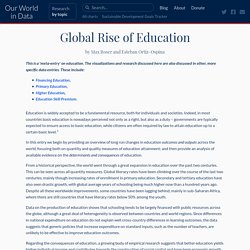
The visualizations and research discussed here are also discussed in other, more specific data entries. These include: 12. SOCI 1301 NOTES - THE BASICS. Site Search and Site Map Table of Contents NOTE: If you only read the basic sociological concepts covered on this page and skip the brief items on the other four pages, you won't correctly understand most of the material and you won't enjoy the course very much.

Las clases sociales en la España del siglo XXI (I): La Clasificación Socioeconómica Europea (ESeC) Por Javier Segura del Pozo.
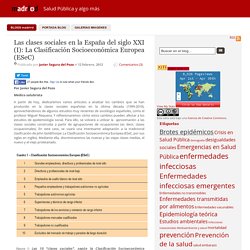
'Towards better prevention and management of chronic diseases' Navigation path.
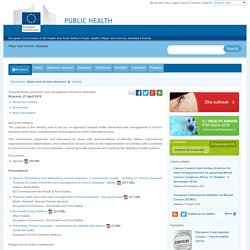
La tasa de pobreza de Canarias afecta al 28,5% de su población. eldia.es. Google Play. Elsevier: Article Locator. Mesa Congreso Nacional semFYC 2011. 1. ¿ A qué nos estamos refiriendo al hablar de DSS en Atención Primaria? Sustainable development goals - United Nations.
Reduce inequality within and among countries - United Nations Sustainable Development. Reduce inequality within and among countriesFlorencia Soto Nino2017-02-21T17:21:42+00:00 Share this story, choose your platform!

The international community has made significant strides towards lifting people out of poverty. The most vulnerable nations – the least developed countries, the landlocked developing countries and the small island developing states – continue to make inroads into poverty reduction. However, inequality still persists and large disparities remain in access to health and education services and other assets. Additionally, while income inequality between countries may have been reduced, inequality within countries has risen.
To reduce inequality, policies should be universal in principle paying attention to the needs of disadvantaged and marginalized populations. Tab content Ahead of Father’s Day, UNICEF cites critical role fathers play in early childhood learning Read More.
_static_tumblr_static_qds32vs630g4so000884ck00_640. Roundtable-Background-Paper-2011. Los jóvenes canarios consumen menos alcohol y drogas que la media nacional. eldia.es. GREDS/EMCONET: Grupo de Investigación en Desigualdades en Salud - ( UPF ) Dr. Fernando Lannes Fernandes. Fernandes, F.L. (2013) Youth Gang Members in Rio de Janeiro: The Face of a “Lost Generation” in an Age of Fear and Mistrust.
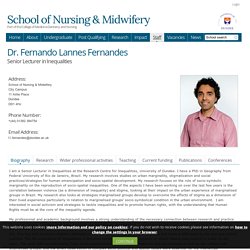
Bulletin of Latin American Studies, 32(2), pp. 210–223. Fernandes, F.L. (2012), The youth from favela. Structural Inequality and Diversity in Nursing - Minority Nurse. Various inequalities exist in structured social systems.
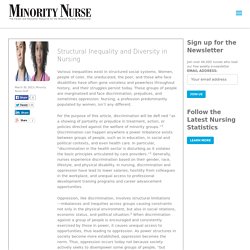
Women, people of color, the uneducated, the poor, and those who face disabilities have often gone voiceless and powerless throughout history, and their struggles persist today. These groups of people are marginalized and face discrimination, prejudices, and sometimes oppression. Social Determinants of Health e-Learning Course. Glossary:Relative median income ratio - Statistics Explained. Glossary:Relative median at-risk-of-poverty gap - Statistics Explained. Glossary:Income quintile share ratio - Statistics Explained. Glossary:Equivalised disposable income - Statistics Explained. The equivalised disposable income is the total income of a household, after tax and other deductions, that is available for spending or saving, divided by the number of household members converted into equalised adults; household members are equalised or made equivalent by weighting each according to their age, using the so-called modified OECD equivalence scale.
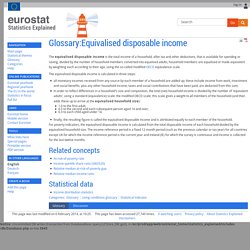
The equivalised disposable income is calculated in three steps: 1.0 to the first adult; 0.5 to the second and each subsequent person aged 14 and over; 0.3 to each child aged under 14. finally, the resulting figure is called the equivalised disposable income and is attributed equally to each member of the household. For poverty indicators, the equivalised disposable income is calculated from the total disposable income of each household divided by the equivalised household size. Glossary:At-risk-of-poverty rate - Statistics Explained. The at-risk-of-poverty rate is the share of people with an equivalised disposable income (after social transfer) below the at-risk-of-poverty threshold, which is set at 60 % of the national median equivalised disposable income after social transfers.

This indicator does not measure wealth or poverty, but low income in comparison to other residents in that country, which does not necessarily imply a low standard of living. Glossary:At-risk-of-poverty rate - Statistics Explained. Indicadores en salud. Los indicadores son variables que intentan medir u objetivar en forma cuantitativa o cualitativa, sucesos colectivos (especialmente sucesos biodemográficos) para así, poder respaldar acciones políticas, evaluar logros y metas.
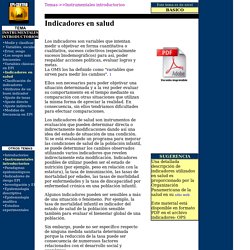
La OMS los ha definido como "variables que sirven para medir los cambios". 1 Ellos son necesarios para poder objetivar una situación determinada y a la vez poder evaluar su comportamiento en el tiempo mediante su comparación con otras situaciones que utilizan la misma forma de apreciar la realidad. En consecuencia, sin ellos tendríamos dificultades para efectuar comparaciones.
07300.pdf. 24_01_05.pdf. Desigualdad, ¿El problema social de los próximos años? - Econstuff. Durante los últimos días la econosfera ha puesto el foco en la desigualdad, un tema de creciente interés tanto por su relación con la actividad económica como por el problema social que representa, en un momento en el que parece que dejamos una crisis económica atrás mientras la crisis social permanece como una parte cada vez más relevante de la nueva realidad que se está gestando. Ya en la reunión que tuvo Janet Yellen con los senadores, un tema recurrente por parte de estos fue preguntarle sobre la desigualdad y lo que se podía hacer para solucionar un problema que a veces no se remedia únicamente con aumentos continuados del PIB.
Diigo - Better reading and research with annotation, highlighter, sticky notes, archiving, bookmarking & more. Create and share visual ideas online. Epidemiologe Wilkinson: "Die Antwort ist simpel: Ungleichheit bringt uns um" - Gesundheitspolitik. Finance & Development, December 2010 - Leveraging Inequality. Finance & Development, December 2010, Vol. 47, No. 4 Michael Kumhof and Romain Rancière PDF version Long periods of unequal incomes spur borrowing from the rich, increasing the risk of major economic crises THE United States experienced two major economic crises over the past 100 years—the Great Depression of 1929 and the Great Recession of 2007. Income inequality may have played a role in the origins of both. Are these two facts connected? Finance & Development, September 2011 - Equality and Efficiency.
Finance & Development, September 2011, Vol. 48, No. 3 Andrew G. Berg and Jonathan D. Ostry PDF version Is there a trade-off between the two or do they go hand in hand? IN his influential 1975 book Equality and Efficiency: The Big Tradeoff, Arthur Okun argued that pursuing equality can reduce efficiency (the total output produced with given resources). Finance & Development, September 2011 - Unequal = Indebted. Finance & Development, September 2011, Vol. 48, No. 3. Free exchange: All men are created unequal. INEQUALITY is one of the most controversial attributes of capitalism. Early in the industrial revolution stagnant wages and concentrated wealth led David Ricardo and Karl Marx to question capitalism’s sustainability. Twentieth-century economists lost interest in distributional issues amid the “Great Compression” that followed the second world war. But a modern surge in inequality has new economists wondering, as Marx and Ricardo did, which forces may be stopping the fruits of capitalism from being more widely distributed.
“Capital in the Twenty-First Century” by Thomas Piketty, an economist at the Paris School of Economics, is an authoritative guide to the question. Free exchange: All men are created unequal. Friedman. United Nations Development Programme. IMF: Income inequality is terrible for economic growth. As the Occupy Wall Street protests swell in size and people pay closer attention to the gap between the wealthiest Americans and everyone else, one question is why this divide even matters. One way to look at income inequality, after all, is that it’s no big deal. If a country is growing at a healthy clip and everyone is steadily getting richer, then it’s hardly an outrage that a few titans at the very top are doing freakishly well, right?
But a recent study from the International Monetary Fund suggests that this conventional view is misguided. Excessive income inequality, the authors find, can actually inflict a lot of harm on a country’s long-term economic prospects. In the IMF’s Finance & Development magazine, the authors, Andrew Berg and Jonathan Ostry, summarize their recent research (see also Josh Harkinson’s piece for Mother Jones). For sustained growth to occur, Berg and Ostry found, the most important factors are a relatively equal income distribution and trade openness. Is inequality bad for economic growth? - The Washington Post. On Wednesday, just as President Obama was giving his big speech on inequality and the economy, the Center for American Progress, a liberal think tank, released three new papers on this very topic.
U.S. one dollar bills are arranged for a photograph in London on Wednesday, Feb. 23, 2011. La desigualdad no deja de crecer. ¿Deberíamos preocuparnos? - Econstuff. La peligrosa epidemia de las enfermedades no infecciosas. La mayor crisis de salud global de los países de renta media y baja no son las enfermedades infecciosas como muchos pueden pensar. Other Google Services/Products. Poverty_book-_the_ecs_of_poverty_fnl.pdf. UK income inequality is among the highest in the developed world and evidence shows that this is bad for almost everyone. UK income inequality is among the highest in the developed world and evidence shows that this is bad for almost everyone. Visualizing Million Voices - The World We Want. World We Want 2015. “La austeridad está provocando un severo problema de salud pública”